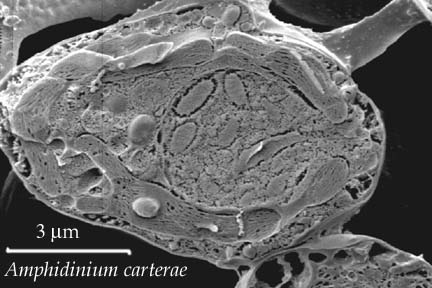Dinoflagellates are fascinating little flagellates that are found in both marine and freshwater environments. One of many reasons that the dinoflagellates are interesting is that within this group, plastids seem to have been acquired several different times in separate secondary endosymbiotic events. This means that there is a great diversity of plastids within the group. We are using genomic methods including cDNA screening and selective sequencing of genomic DNA to study how the dinoflagellate plastid is incorporated into its host cell.
The micrograph to the right (an SEM image by Eliot Herman) shows both the chloroplast and nucleus of Amphidinium carterae in a freeze-sectioned cell. Amphidinium is one of our primary study organisms. It has the advantages of being relatively easy to grow, having a relatively small nuclear genome (ca.10E10 BP, roughly comparable to the human genome)
